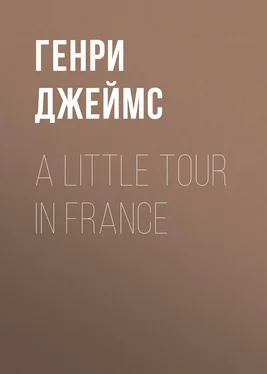Генри Джеймс - A Little Tour in France
Здесь есть возможность читать онлайн «Генри Джеймс - A Little Tour in France» — ознакомительный отрывок электронной книги совершенно бесплатно, а после прочтения отрывка купить полную версию. В некоторых случаях можно слушать аудио, скачать через торрент в формате fb2 и присутствует краткое содержание. Жанр: Путешествия и география, foreign_antique, foreign_prose, на английском языке. Описание произведения, (предисловие) а так же отзывы посетителей доступны на портале библиотеки ЛибКат.
- Название:A Little Tour in France
- Автор:
- Жанр:
- Год:неизвестен
- ISBN:нет данных
- Рейтинг книги:4 / 5. Голосов: 1
-
Избранное:Добавить в избранное
- Отзывы:
-
Ваша оценка:
- 80
- 1
- 2
- 3
- 4
- 5
A Little Tour in France: краткое содержание, описание и аннотация
Предлагаем к чтению аннотацию, описание, краткое содержание или предисловие (зависит от того, что написал сам автор книги «A Little Tour in France»). Если вы не нашли необходимую информацию о книге — напишите в комментариях, мы постараемся отыскать её.
A Little Tour in France — читать онлайн ознакомительный отрывок
Ниже представлен текст книги, разбитый по страницам. Система сохранения места последней прочитанной страницы, позволяет с удобством читать онлайн бесплатно книгу «A Little Tour in France», без необходимости каждый раз заново искать на чём Вы остановились. Поставьте закладку, и сможете в любой момент перейти на страницу, на которой закончили чтение.
Интервал:
Закладка:
Pass beneath it into the court, and the sixteenth century closes round you. It is a pardonable flight of fancy to say that the expressive faces of an age in which human passions lay very near the surface seem to look out at you from the windows, from the balconies, from the thick foliage of the sculpture. The portion of the wing of Louis XII. that looks toward the court is supported on a deep arcade. On your right is the wing erected by Francis I., the reverse of the mass of building which you see on approaching the castle. This exquisite, this extravagant, this trans- cendent piece of architecture is the most joyous ut- terance of the French Renaissance. It is covered with an embroidery of sculpture, in which every detail is worthy of the hand of a goldsmith. In the middle of it, or rather a little to the left, rises the famous wind- ing staircase (plausibly, but I believe not religiously, restored), which even the ages which most misused it must vaguely have admired. It forms a kind of chiselled cylinder, with wide interstices, so that the stairs are open to the air. Every inch of this structure, of its balconies, its pillars, its great central columns, is wrought over with lovely images, strange and ingenious devices, prime among which is the great heraldic sala- mander of Francis I. The salamander is everywhere at Blois, – over the chimneys, over the doors, on the walls. This whole quarter , of the castle bears the stamp of that eminently pictorial prince. The run- ning cornice along the top of the front is like all un- folded, an elongated, bracelet. The windows of the attic are like shrines for saints. The gargoyles, the medallions, the statuettes, the festoons, are like the elaboration of some precious cabinet rather than the details of a building exposed to the weather and to the ages. In the interior there is a profusion of res- toration, and it is all restoration in color. This has been, evidently, a work of great energy and cost, but it will easily strike you as overdone. The universal freshness is a discord, a false note; it seems to light up the dusky past with an unnatural glare. Begun in the reign of Louis Philippe, this terrible process – the more terrible always the more you admit that it has been necessary – has been carried so far that there is now scarcely a square inch of the interior that has the color of the past upon it. It is true that the place had been so coated over with modern abuse that something was needed to keep it alive; it is only, per- haps, a pity that the restorers, not content with saving its life, should have undertaken to restore its youth. The love of consistency, in such a business, is a dangerous lure. All the old apartments have been rechristened, as it were; the geography of the castle has been re-established. The guardrooms, the bed- rooms, the closets, the oratories, have recovered their identity. Every spot connected with the murder of the Duke of Guise is pointed out by a small, shrill boy, who takes you from room to room, and who has learned his lesson in perfection. The place is full of Catherine de' Medici, of Henry III., of memories, of ghosts, of echoes, of possible evocations and revivals. It is covered with crimson and gold. The fireplaces and the ceilings are magnificent; they look like ex- pensive "sets" at the grand opera.
I should have mentioned that below, in the court, the front of the wing of Gaston d'Orleans faces you as you enter, so that the place is a course of French history. Inferior in beauty and grace to the other portions of the castle, the wing is yet a nobler monu- ment than the memory of Gaston deserves. The second of the sons of Henry IV., – who was no more fortunate as a father than as a husband, – younger brother of Louis XIII., and father of the great Mademoiselle, the most celebrated, most ambitious, most self-complacent, and most unsuccessful fille a marier in French history, passed in enforced retirement at the castle of Blois the close of a life of clumsy intrigues against Cardinal Richelieu, in which his rashness was only equalled by his pusillanimity and his ill-luck by his inaccessibility to correction, and which, after so many follies and shames, was properly summed up in the project – be- gun, but not completed – of demolishing the beautiful habitation of his exile in order to erect a better one. With Gaston d'Orleans, however, who lived there with- out dignity, the history of the Chateau de Blois de- clines. Its interesting period is that of the wars of religion. It was the chief residence of Henry III., and the scene of the principal events of his depraved and dramatic reign. It has been restored more than enough, as I have said, by architects and decorators; the visitor, as he moves through its empty rooms, which are at once brilliant and ill-lighted (they have not been re- furnished), undertakes a little restoration of his own. His imagination helps itself from the things that re- main; he tries to see the life of the sixteenth century in its form and dress, – its turbulence, its passions, its loves and hates, its treacheries, falsities, touches of faith, its latitude of personal development, its presen- tation of the whole nature, its nobleness of costume, charm of speech, splendor of taste, unequalled pic- turesqueness. The picture is full of movement, of contrasted light and darkness, full altogether of abomi- nations. Mixed up with them all is the great name of religion, so that the drama wants nothing to make it complete. What episode was ever more perfect – looked at as a dramatic occurrence – than the murder of the Duke of Guise? The insolent prosperity of the victim; the weakness, the vices, the terrors, of the author of the deed; the perfect execution of the plot; the accu- mulation of horror in what followed it, – give it, as a crime, a kind of immortal solidity.
But we must not take the Chateau de Blois too hard: I went there, after all, by way of entertainment. If among these sinister memories your visit should threaten to prove a tragedy, there is an excellent way of removing the impression. You may treat yourself at Blois to a very cheerful afterpiece. There is a charming industry practised there, and practised in charming conditions. Follow the bright little quay down the river till you get quite out of the town, and reach the point where the road beside the Loire be- comes sinuous and attractive, turns the corner of dimi- nutive headlands, and makes you wonder what is be- yond. Let not your curiosity induce you, however, to pass by a modest white villa which overlooks the stream, enclosed in a fresh little court; for here dwells an artist, – an artist in faience. There is no sort of sign, and the place looks peculiarly private. But if you ring at the gate, you will not be turned away. You will, on the contrary, be ushered upstairs into a parlor – there is nothing resembling a shop- encum- bered with specimens – of remarkably handsome pottery. The work is of the best, – a careful reproduction of old forms, colors, devices; and the master of the establishment is one of those completely artistic types that are often found in France. His reception is as friendly as his work is ingenious; and I think it is not too much to say that you like the work the better be- cause he has produced it. His vases, cups and jars, lamps, platters, plaques, with their brilliant glaze, their innumerable figures, their family likeness, and wide variations, are scattered, through his occupied rooms; they serve at once as his stock-in-trade and as house- hold ornament. As we all know, this is an age of prose, of machinery, of wholesale production, of coarse and hasty processes. But one brings away from the establishment of the very intelligent M. Ulysse the sense of a less eager activity and a greater search for perfection. He has but a few workmen, and he gives them plenty of time. The place makes a little vignette, leaves an impression, – the quiet white house in its garden on the road by the wide, clear river, without the smoke, the bustle, the ugliness, of so much of our modern industry. It ought to gratify Mr. Ruskin.
Читать дальшеИнтервал:
Закладка:
Похожие книги на «A Little Tour in France»
Представляем Вашему вниманию похожие книги на «A Little Tour in France» списком для выбора. Мы отобрали схожую по названию и смыслу литературу в надежде предоставить читателям больше вариантов отыскать новые, интересные, ещё непрочитанные произведения.
Обсуждение, отзывы о книге «A Little Tour in France» и просто собственные мнения читателей. Оставьте ваши комментарии, напишите, что Вы думаете о произведении, его смысле или главных героях. Укажите что конкретно понравилось, а что нет, и почему Вы так считаете.












